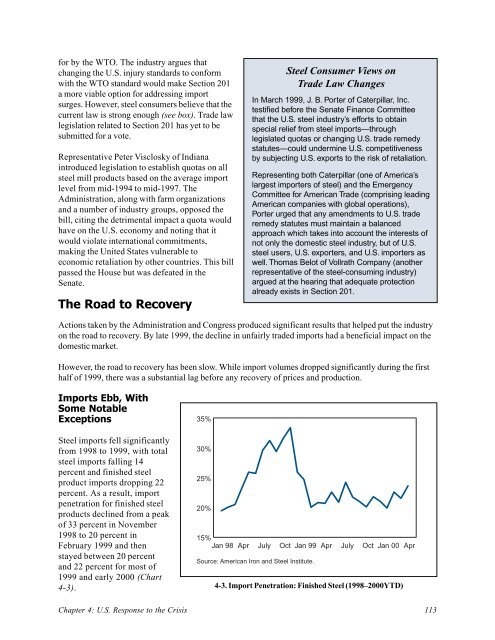Global Steel Trade; Structural Problems and Future Solutions
Global Steel Trade; Structural Problems and Future Solutions
Global Steel Trade; Structural Problems and Future Solutions
You also want an ePaper? Increase the reach of your titles
YUMPU automatically turns print PDFs into web optimized ePapers that Google loves.
for by the WTO. The industry argues that<br />
changing the U.S. injury st<strong>and</strong>ards to conform<br />
with the WTO st<strong>and</strong>ard would make Section 201<br />
a more viable option for addressing import<br />
surges. However, steel consumers believe that the<br />
current law is strong enough (see box). <strong>Trade</strong> law<br />
legislation related to Section 201 has yet to be<br />
submitted for a vote.<br />
Representative Peter Visclosky of Indiana<br />
introduced legislation to establish quotas on all<br />
steel mill products based on the average import<br />
level from mid-1994 to mid-1997. The<br />
Administration, along with farm organizations<br />
<strong>and</strong> a number of industry groups, opposed the<br />
bill, citing the detrimental impact a quota would<br />
have on the U.S. economy <strong>and</strong> noting that it<br />
would violate international commitments,<br />
making the United States vulnerable to<br />
economic retaliation by other countries. This bill<br />
passed the House but was defeated in the<br />
Senate.<br />
The Road to Recovery<br />
<strong>Steel</strong> Consumer Views on<br />
<strong>Trade</strong> Law Changes<br />
In March 1999, J. B. Porter of Caterpillar, Inc.<br />
testified before the Senate Finance Committee<br />
that the U.S. steel industry’s efforts to obtain<br />
special relief from steel imports—through<br />
legislated quotas or changing U.S. trade remedy<br />
statutes—could undermine U.S. competitiveness<br />
by subjecting U.S. exports to the risk of retaliation.<br />
Representing both Caterpillar (one of America’s<br />
largest importers of steel) <strong>and</strong> the Emergency<br />
Committee for American <strong>Trade</strong> (comprising leading<br />
American companies with global operations),<br />
Porter urged that any amendments to U.S. trade<br />
remedy statutes must maintain a balanced<br />
approach which takes into account the interests of<br />
not only the domestic steel industry, but of U.S.<br />
steel users, U.S. exporters, <strong>and</strong> U.S. importers as<br />
well. Thomas Belot of Vollrath Company (another<br />
representative of the steel-consuming industry)<br />
argued at the hearing that adequate protection<br />
already exists in Section 201.<br />
Actions taken by the Administration <strong>and</strong> Congress produced significant results that helped put the industry<br />
on the road to recovery. By late 1999, the decline in unfairly traded imports had a beneficial impact on the<br />
domestic market.<br />
However, the road to recovery has been slow. While import volumes dropped significantly during the first<br />
half of 1999, there was a substantial lag before any recovery of prices <strong>and</strong> production.<br />
Imports Ebb, With<br />
Some Notable<br />
Exceptions<br />
35%<br />
<strong>Steel</strong> imports fell significantly<br />
from 1998 to 1999, with total 30%<br />
steel imports falling 14<br />
percent <strong>and</strong> finished steel<br />
25%<br />
product imports dropping 22<br />
percent. As a result, import<br />
penetration for finished steel<br />
20%<br />
products declined from a peak<br />
of 33 percent in November<br />
1998 to 20 percent in<br />
February 1999 <strong>and</strong> then<br />
stayed between 20 percent<br />
Source: American Iron <strong>and</strong> <strong>Steel</strong> Institute.<br />
<strong>and</strong> 22 percent for most of<br />
1999 <strong>and</strong> early 2000 (Chart<br />
4-3). 4-3. Import Penetration: Finished <strong>Steel</strong> (1998–2000YTD)<br />
15%<br />
Jan 98 Apr July Oct Jan 99 Apr July Oct Jan 00 Apr<br />
Chapter 4: U.S. Response to the Crisis 113
















